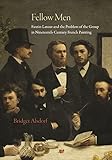Fellow Men : Fantin-Latour and the Problem of the Group in Nineteenth-Century French Painting / Bridget Alsdorf.
Material type: TextPublisher: Princeton, NJ : Princeton University Press, [2022]Copyright date: ©2013Description: 1 online resource (352 p.) : 42 color illus. 122 halftonesContent type:
TextPublisher: Princeton, NJ : Princeton University Press, [2022]Copyright date: ©2013Description: 1 online resource (352 p.) : 42 color illus. 122 halftonesContent type: - 9781400845125
- Art and society -- France -- History -- 19th century
- Artists -- France -- Portraits
- Group identity in art
- Portrait painting, French -- 19th century
- Portraits, Group -- France
- ART / History / Modern (late 19th Century to 1945)
- Academic art
- Alfred Sisley
- Allegory
- Alois Riegl
- Alphonse Legros
- Ambroise Vollard
- Anomie
- Antoine Guillemet
- Apotheosis
- Art criticism
- Arthur Rimbaud
- Bad Painting
- Banality (sculpture series)
- Bohemian style
- Boredom
- Bourgeoisie
- Camille Pissarro
- Caricature
- Carle Vernet
- Champfleury
- Charles Baudelaire
- Cubism
- Degenerate art
- Easel
- Edgar Allan Poe
- Edgar Degas
- Edmund Gosse
- Emmanuel Chabrier
- Enfant terrible
- Exclusion
- Farce
- Fine art
- Frans Hals
- French art
- Genre painting
- Georg Simmel
- Gustave Caillebotte
- Gustave Courbet
- Gustave Moreau
- Hedda Sterne
- Henri Fantin-Latour
- History painting
- Homage (arts)
- Horace Vernet
- Hyperbole
- Impressionism
- Jacques Derrida
- Jacques-Louis David
- James Abbott McNeill Whistler
- James Tissot
- Jan van Eyck
- Jean-Auguste-Dominique Ingres
- John Ashbery
- John Rewald
- Joseph de Maistre
- Juan Bautista Martínez del Mazo
- Jules Dalou
- L'Artiste
- La Vie (painting)
- Las Meninas
- Le Déjeuner sur l’herbe
- Les Nabis
- Linda Nochlin
- Literature
- Louis Blanc
- Luncheon of the Boating Party
- Marthe
- Mary Cassatt
- Masculinity
- Maurice Denis
- Michael Fried
- Modernism
- Modernity
- Music in the Tuileries
- Narcissism
- Nude (art)
- Obscenity
- Oil sketch
- Painting
- Paul Delaroche
- Paul Gauguin
- Paul Verlaine
- Photography
- Physiognomy
- Pierre-Auguste Renoir
- Postmodern literature
- Public morality
- Realism (arts)
- Rembrandt
- Ridicule
- Rococo
- Romanticism
- Sketchbook
- Soziologie
- Still life
- The Artist at Work
- The Irascibles
- The Painter's Studio
- The Philosopher
- Édouard Manet
- 759.4 23
- ND553.F32 A85 2013eb
- online - DeGruyter
| Item type | Current library | Call number | URL | Status | Notes | Barcode | |
|---|---|---|---|---|---|---|---|
 eBook
eBook
|
Biblioteca "Angelicum" Pont. Univ. S.Tommaso d'Aquino Nuvola online | online - DeGruyter (Browse shelf(Opens below)) | Online access | Not for loan (Accesso limitato) | Accesso per gli utenti autorizzati / Access for authorized users | (dgr)9781400845125 |
Browsing Biblioteca "Angelicum" Pont. Univ. S.Tommaso d'Aquino shelves, Shelving location: Nuvola online Close shelf browser (Hides shelf browser)

|

|

|

|

|

|

|
||
| online - DeGruyter Life Exposed : Biological Citizens after Chernobyl / | online - DeGruyter Camille Saint-Saëns and His World / | online - DeGruyter Mozart's Grace / | online - DeGruyter Fellow Men : Fantin-Latour and the Problem of the Group in Nineteenth-Century French Painting / | online - DeGruyter After Art / | online - DeGruyter Heart Beats : Everyday Life and the Memorized Poem / | online - DeGruyter Morgantina Studies, Volume VI : The Hellenistic and Roman Fine Pottery / |
Frontmatter -- Contents -- Acknowledgments -- Introduction -- 1. The Self in Group Portraiture -- 2. A Crisis of Pride -- 3. Studio of the Self -- 4. Deviance and Disappearance -- 5. The Irregularists -- Conclusion -- Notes -- Selected Bibliography -- Index
restricted access online access with authorization star
http://purl.org/coar/access_right/c_16ec
Focusing on the art of Henri Fantin-Latour (1836-1904) and his colleagues Gustave Courbet, Edgar Degas, Edouard Manet, Frédéric Bazille, and Pierre-Auguste Renoir, Fellow Men argues for the importance of the group as a defining subject of nineteenth-century French painting. Through close readings of some of the most ambitious paintings of the realist and impressionist generation, Bridget Alsdorf offers new insights into how French painters understood the shifting boundaries of their social world, and reveals the fragile masculine bonds that made up the avant-garde.A dedicated realist who veered between extremes of sociability and hermetic isolation, Fantin-Latour painted group dynamics over the course of two decades, from 1864 to 1885. This was a period of dramatic change in French history and art--events like the Paris Commune and the rise and fall of impressionism raised serious doubts about the power of collectivism in art and life. Fantin-Latour's monumental group portraits, and related works by his friends and colleagues from the 1850s through the 1880s, represent varied visions of collective identity and test the limits of association as both a social and an artistic pursuit. By examining the bonds and frictions that animated their social circles, Fantin-Latour and his cohorts developed a new pictorial language for the modern group: one of fragmentation, exclusion, and willful withdrawal into interior space that nonetheless presented individuality as radically relational.
Mode of access: Internet via World Wide Web.
In English.
Description based on online resource; title from PDF title page (publisher's Web site, viewed 29. Jul 2022)


